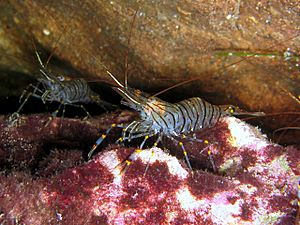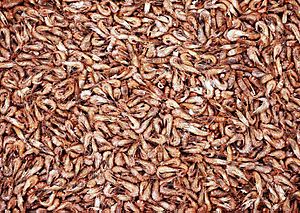Shrimp facts for kids
Quick facts for kids Shrimp |
|
|---|---|
 |
|
| Palaemon serratus, a caridean shrimp | |
| Scientific classification | |
| Kingdom: | |
| Phylum: | |
| Class: | |
| Order: | |
Shrimp are small, interesting sea creatures. They belong to a group of animals called crustaceans, which also includes crabs and lobsters. Shrimp are found all over the world in many different watery places, from oceans to rivers. There are thousands of different kinds of shrimp, and they play a big part in the ocean's food web.
Contents
What Are Shrimp?
Shrimp are a type of decapod crustacean. This means they have ten legs, like crabs and lobsters. Most shrimp are small, but their size can vary a lot between different species.
There are three main groups of shrimp:
- Caridea
- Procarididea
- Dendrobranchiata
Many small crustaceans that look like shrimp are often called shrimp, even if they are not exactly the same type.
Where Do Shrimp Live?
Adult shrimp usually live close to the bottom of the water. They are often found in large groups called schools. Shrimp are known for being able to swim very fast backwards!
Shrimp are important in the food chain. They are a food source for many larger animals, from fish to even whales. They help keep the ocean healthy by eating tiny bits of food from the water.
Shrimp vs. Prawns
Sometimes people get confused between shrimp and prawns. In cooking, prawns are often just bigger shrimp. But biologically, there's a difference!
You can tell prawns and shrimp apart by looking at their gills. Prawns have gills that branch out like a tree. Shrimp, on the other hand, have gills that are not branched.
Shrimp as Food
Many types of shrimp are caught and eaten by people all over the world. The part of the shrimp that people usually eat is the muscular tail. Before eating, the head and the digestive tract are often removed.
Shrimp are a very popular seafood. In fact, so many shrimp are eaten that there's a huge industry around catching and farming them. Shrimp farming became very popular in the 1980s, especially in China. Today, more shrimp are grown on farms than are caught in the wild.
Sometimes, shrimp farms can affect the environment, especially in areas like estuaries (where rivers meet the sea).
Related pages
Images for kids
-
Global wild capture, 1950–2010, in million tonnes, as reported by the FAO
-
Global aquaculture production 1970–2009, in million tonnes, as reported by the FAO
See also
 In Spanish: Gamba (crustáceo) para niños
In Spanish: Gamba (crustáceo) para niños









